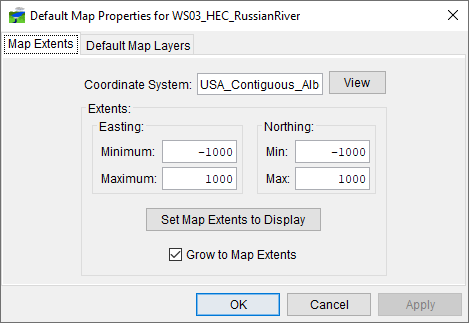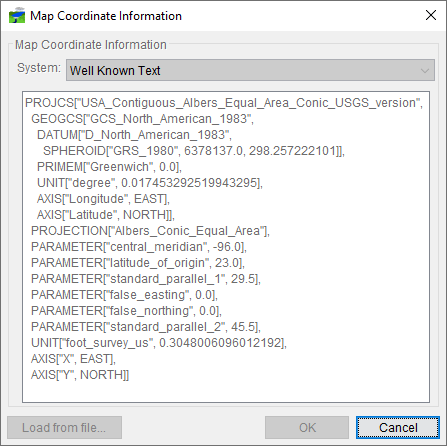Geographic Reference for Map Layers
To maintain a geographic reference (also called a geo-reference), HEC-RTS uses a user-selected and customizable coordinate system, called the World Coordinate System (WCS). This superimposes a grid on layer features to establish x and y coordinates in WCS for each point on the layer. The x-coordinate is referred to as "easting", and the y-coordinate is referred to as "northing". You can select the extent of this grid, the dimensions of the cells of the grid, the units of measurement of the grid, and the location of the origin of the grid. Because of this flexibility, the user can specify and use virtually any grid coordinates convenient for HEC-RTS model integration. To establish geographic reference:
- From the HEC-RTS main window, from the Maps menu, click Default Map Properties. The Default Map Properties dialog (Figure 1) will open.

The Default Map Properties dialog contains two tabs: Map Extents and Default Map Layers. The Map Extents tab includes:
Coordinate System This field identifies the established coordinate system for the watershed. To view the coordinate system, click View. The Map Coordinate Information dialog (Figure 2) will open, providing you with information about the coordinate system that was established when the watershed was created. You are not able to edit this information. Extents Easting Minimum and Maximum; Northing Minimum and Maximum. These values (Figure 1) indicate the location of the left, right, bottom, and top borders (respectively) of the grid in the map window.

Set Map Extents to Display This will set the limits of the map window. If you zoom in on an area and click Set Map Extents to Display, the extents on the Default Map Properties dialog (Figure 1) will change to the zoomed area. Grow to Map Extents When selected, HEC-RTS automatically sets the geographic extents to define the smallest rectangle that encompasses all the objects in the watershed. The geographic extents of map layers must be selected carefully to ensure that the entire watershed is included. HEC-RTS can transform map layer coordinates "on-the-fly" if coordinate systems are defined properly in ways that HEC-RTS can determine the coordinate system. For example, for an Arc shapefile there is an associated projection (.prj) file. The projection file contains the mathematical formulas to relate spherical coordinates on the globe to flat, planar coordinates. Therefore, you may need to use GIS tools to identify or transform the layers from one coordinate system to another before using them with HEC-RTS.
The Default Map Layers tab (Figure 1) includes a list of map layers that are being displayed in a map window. You use check boxes to display or hide map layers.